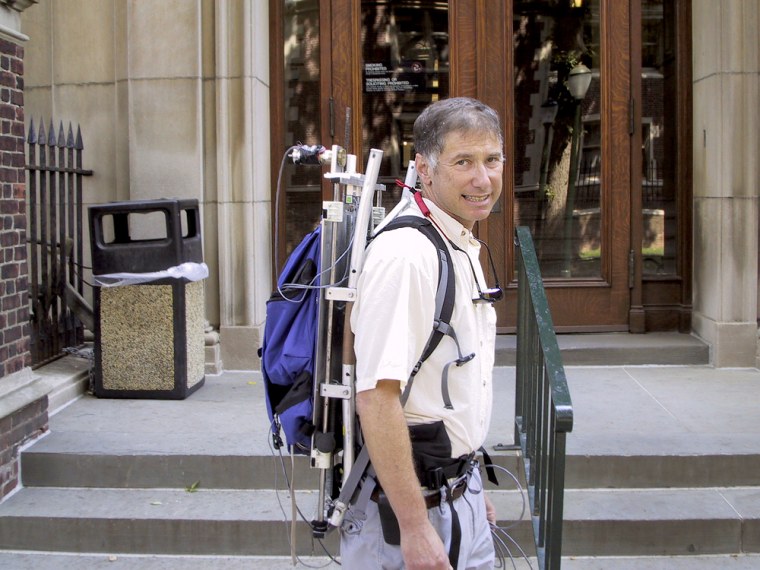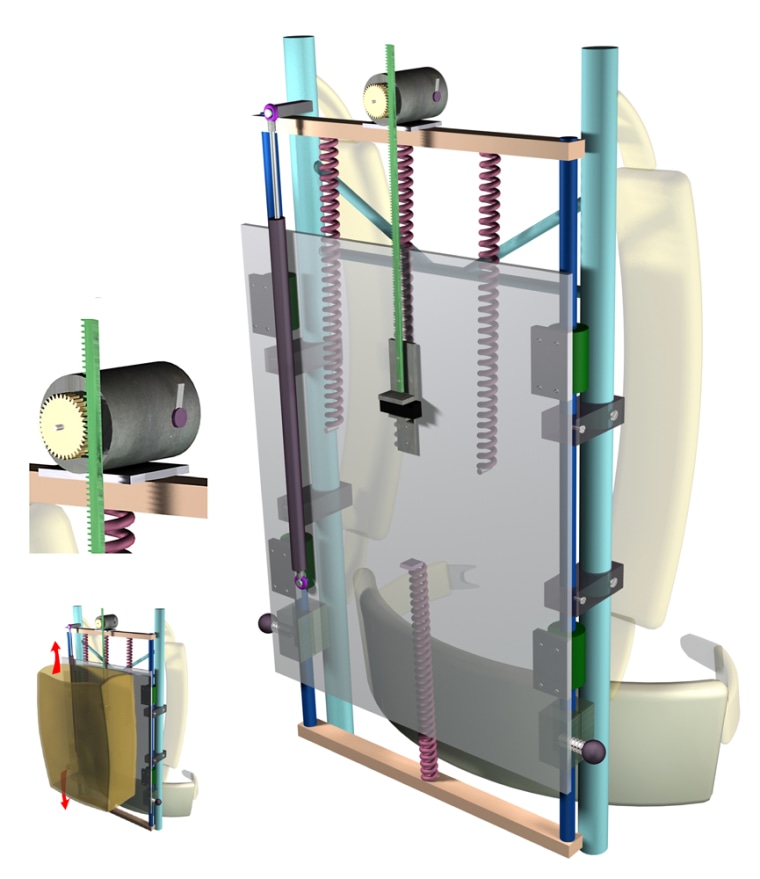In the days immediately following Hurricane Katrina, radio and phone communication suffered, in part, when rechargeable batteries died and could not be recharged due to widespread power outages. A new backpack design may offer a way for first responders and disaster relief workers to generate their own electricity for communications devices, night vision goggles, water purifiers or other crucial, portable electronics.
All the person wearing the backpack has to do is walk — the backpack does the rest. The backpack captures energy from the up-and-down movements of its heavy contents and converts this energy to electricity.
The new research is published in the Sept. 9 issue of the journal Science published by AAAS, the nonprofit science society.
“I wrote the first draft of the Science paper during the relief effort following the 2004 tsunami. I was struck by continual reports of people not being able to communicate because satellite phone batteries went dead,” said backpack inventor Larry Rome.
In light of the power outages that are burdening relief efforts in the aftermath of Hurricane Katrina, it’s clear that disaster relief workers who can generate their own electricity would be more effective than relief workers without the ability to generate their own power, explained Rome, a biology professor from the University of Pennsylvania in Philadelphia, PA and the Marine Biological Laboratory in Woods Hole, MA.
The backpack looks a lot like the metal framed packs people use to carry their gear during long trips. The backpack captures energy from this movement with a series of gears connected to an electric generator.
“The idea behind the suspended-load backpack isn’t complicated. It just took a person with the right background and a little creativity to put the pieces together,” said Rome.

Rome is an accidental backpack inventor. Much of his research is focused on the muscles that allow fish to swim and frogs to jump. He first envisioned a backpack as a sustainable way for humans to generate electricity from walking when he worked on a project aimed at making a submersible vehicle that swims like a fish.
Electrifying hip movement
The side-to-side sway of a person’s hips may be more familiar, but it’s the up-and-down movement of the hips that can power a gadget that feeds on electricity.
When you walk, you put one foot down and then your body vaults over that leg, causing the hip to move up and down by about five centimeters.
If you are carrying a heavy backpack when you walk, it takes extra energy to vault the backpack over your leg. The new backpack harvests this energy by separating the movement of the backpack’s heavy cargo from the movement of the frame.
The cargo compartment of the new backpack, which was filled to weigh between 20 and 38 kilograms (44 to 83 pounds) for a variety of trials, is suspended by springs and moves up and down with respect to the frame. It is this movement of the cargo compartment with respect to the frame that turns a gear connected to an electric generator that is mounted to the frame. Inside this generator, coils of wire within a magnetic field turn when you walk, leading to the production of electricity.
In one backpack “test drive,” the backpack consistently harvested about 7 watts. For comparison, cell phones, global positioning system receivers, and LED headlamps each use less than one watt. So, it appears that walking with the backpack could allow the wearer to run multiple devices at the same time. The generated electricity could also be used to charge batteries.
An 80 pound backpack worn by a disaster relief worker or field scientist often includes 20 pounds of replacement batteries, so the new backpack could allow people to carry fewer replacement batteries.
Power walking for real
There are many creative, though not always efficient, ways to generate electricity on a small scale. For example, a spinning hamster wheel generates enough energy to power a cell phone.

Efficiency is a critical issue for any energy harvesting technique. Clearly, carrying a hamster and all its supplies into the wilderness is much harder than carrying a cell phone replacement battery. Similarly, if carrying the new backpack burned huge numbers of calories, compared to a regular backpack of the same weight, then you would need to carry so much extra food that simply carrying extra batteries might be more efficient.
A series of treadmill tests measuring how much human energy it takes to walk with the backpack revealed that the backpack can serve as an efficient source of electricity. It’s true that you burn a few more calories when you walk with the backpack than a traditional backpack of the same weight. But, you are generating electricity at the same time, and the weight of the extra food that you must carry is far less than the weight of the batteries that would be required if you didn’t have an electricity-harvesting backpack, making this source of energy a “good deal.”
Leg vaulting
The backpack inventors are still in the process of figuring out why the new backpack lets you walk so efficiently. It appears that your leg muscles save energy during the transition between steps: when both feet are on the ground, your legs are bent and your leg muscles are working hard.
Also, each leg appears to supports a greater share of the weight of the pack than usual at the “top” of each step, when only one leg is on the ground. This leg is relatively straight. During this phase of each step, when the body is vaulting over the extended leg, adding extra weight doesn’t make much of a difference.
It is these subtle differences that could make this backpack more comfortable to wear and better for your back, said Arthur Kuo, an engineer from the University of Michigan in Ann Arbor, MI. Kuo wrote a background article that accompanies the new Science research.
“The backpack’s suspension system might make it more comfortable to wear and the gain in comfort might be well worth it, even without the energy-harvesting capacity,” he said.